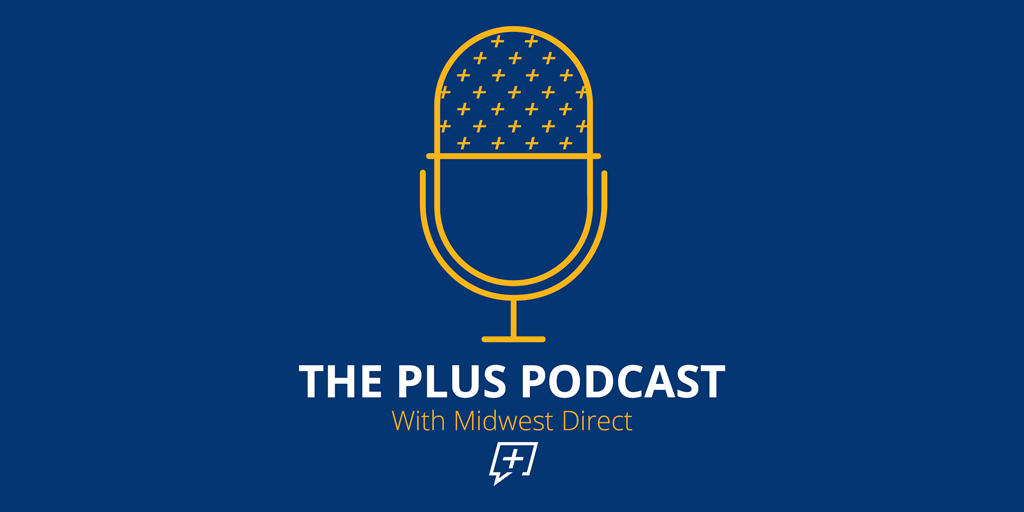A Strategic Marketing Campaign involves much more than just scheduling social media or developing a flyer. Before you jump into developing your plan, you need good answers to the following questions:
- Who is your audience?
- Why are you developing this campaign?
- What is the mission of this campaign?
- How will you get your message out?
That’s where this episode of The Plus Podcast comes in. Today we will deep dive into what it takes to answer these questions and how Midwest Direct can help you with them.
Listen to this episode of The Plus Podcast to learn more about developing your strategic marketing plan.
Who is your audience?
When it comes to defining your audience, most companies narrow down their target market to a geographic area, an age group, etc. This is a great place to start, but if you’ve been tracking your sales, you can build data-driven personas that are much more accurate and relevant. Data-driven personas help you to know and understand who your audience is, what they want and empower you to segment for messages that connect. Use your historical data and your own sales records to match back actual purchasers to build your personas and their customer journey. This gives you an excellent basis to develop look-alike prospect campaigns. Successful marketers also track who should be -- but is not -- buying and find patterns in customer journeys leading to defection. Smart marketers then develop campaigns to counteract defection – turning potential defectors into loyal customers with targeted retention campaigns.
Here are some things you may want to include when developing a persona:
B2C
- Name, age, and household income
- Marital status
- Family size
- Hobbies, interests, and entertainment
- Buying History
- Motivations and inhibitors to buy
B2B
- Current job role
- Company size and industry
- Geographic information
- Goals or challenges
- Cross-sell potential
- Buying History
Why are you developing this campaign?
This first question seems like it would be self-explanatory, and you may want to answer something like “to gain more sales” or “drive more people to my website”. However, the answer to this question is a little bit more in-depth than that. Simon Sinek has a great Ted Talk on inspiring action through the “why” of things. Sinek says, “people don't buy what you do; people buy why you do it.” We often know what our companies’ product or services are, and how they function, but we don’t know why they are doing it, or we may not know why it was started in the first place.
Here at Midwest Direct, we are well acquainted with the struggle to keep the “why” of what we do present while we are all busy doing what we do. In an interview a few years ago, Founder and Chairman of the Board Jim Gebbie stated, “Defining who we are throughout the years has been a challenge, and I feel that this is probably a common challenge for businesses to have. We really had to sit down and determine our core competencies and also find ways to diversify.”
As our industry has changed, Midwest Direct has had its own struggles to discover and redefine our “why". We continuously update our internal understanding of why our clients need us and how we can increase the value we offer them.
Our strategic marketing plan was built to convey our “why” statement. Each tweet, LinkedIn ad, flyer, podcast episode, and blog post we put out, fits into the overall plan to answer our client’s and prospect’s need for information we can provide. It helps us, and our audience knows who we are and why we do what we do.
What is the goal of this campaign?
Now is the time to start defining your goal, such as how you will achieve your goal “to gain more sales” or “drive more people to my website”. Bear in mind, while campaigns may achieve multiple outcomes, they need a clearly defined, well-benchmarked goal at the outset. Pick a primary goal and, maybe, a secondary goal – no more. Some of the most common missions are:
- Lead conversion and nurturing for prospects
- Customer loyalty and retention
- Customer up-sell or cross-sell
- Develop passionate subscribers and brand sharing
Lead conversion is one of the most basic marketing efforts. You create and publish content to drive your target to interact with you via any lead capture tool, then pass the lead off to sales for a sales close. If that doesn’t happen at the first engagement (and it usually doesn’t), you’ll need to develop a nurturing campaign to add opportunities to intrigue and engage until they convert into a lead.
Customer loyalty and retention begins once you have converted them into a customer and you don’t want to lose them. Loyalty programs and retention campaigns offer current clients additional incentives to keep buying from you. These usually look like “friends and family” offers, anniversary sales, members-only offers, etc. Customer loyalty can be built with financial incentives, but something as simple as a regular newsletter with tips and information relevant to them or blog posts that inform can boost your brand image with clients.
Up-selling and cross-selling are one of the best methods available to a business for growth. It’s achieved in much the same way as customer loyalty. Maintain a close connection with customers. When the opportunity comes, they will look to you for more. If you have consistent cross-selling messages available, you make it easy for them to buy from someone they already know.
Last, but certainly not least, is to develop passionate fans who spread the good word about your company. These are the people who share your updates on LinkedIn without being asked to. They forward the email you sent them to a co-worker or their boss. These people are repeat customers, so you should create campaigns to make them feel special. Offer them exclusive deals to show your appreciation, and they will spread the word to all their friends.
How do you get your message out?
This is the easy part! Now that you know your “why", you’ve nailed down your data-driven personas, and you know your campaign method, you just need to begin reaching out.
Use your “why” and your persona to develop your message. Ask yourself the question “what point am I trying to get across and how does it pertain to the pain points of my audience?” Your message should answer that question. Audiences are very visual. Plan to develop strong visuals for each channel on which you will communicate. When developing this keep in mind your persona(s) and what will appeal to them. It might take a few iterations to get it right. Be sure to A/B test your message/offer and creative to ensure you're campaign is on solid ground.
Now it's time to ramp up and release to your full audience. Decide how many channels you'll integrate when sending out a mailing, email, targeted display ads, social media, etc. Keep your audience and their behaviors top of mind through the process -- and release!
Feeling a bit overwhelmed? Contact our marketing team for help with building data-driven processes, developing your message, and releasing it in mail, email, and online.
Subscribe for more:
Find us on social media with #ThePlusPodcast
Facebook • Twitter • LinkedIn • Instagram
To learn how we can help you achieve your marketing goals with our mailing, data, strategic marketing, email marketing, and online advertising goals, please contact us at info@mw-direct.com or give us a call at 1.800.686.6666.




